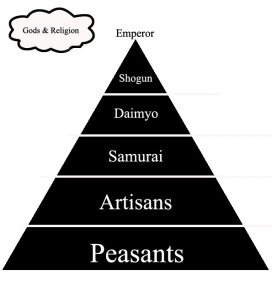Describe the hierarchy of Japan's feudal society.

The emporer of Japan was considered to be the ruler of Japan, though really he was only a figurehead and puppet to the shogun. The shogun had all of the real power in this society. Shoguns were the supreme rulers of the military and the rulers of the country. This mix of power created a very military based Japan and this type of country remained for about 700 years. The samurai were the strong warriors of Japan and vowed to protect the emporer, shogun, and daimyos. During this period of a military Japan, women had a very high status for their time and some even became samurai vowing to protect the shogun. All samurai took an oath to follow one code called Bushido. Bushido was a code of the samurai, not written down, but rather passed along by words. It called for honor, loyalty, and bravery from all of Japan's samurai. The emperor was considered the top of the society of Japan, but really had no power or say in the course of action in Japan's government. Next came the shogun, who had all of the true power of Japan's government and controled the military. The other daimyos came next and were the powerful landowners. The military and samurai warriors came after the daimyos. They were fairly powerful and protected their country. The samurai, though, only made up about less than 10% of the population of the Japanese society. Next up were the peasants and artisans. They made up about 90% of the poulation and produced almost everything of Japan. The peasants usually farmed and the artisans produced much of Japan's pottery and other items. They would sell these items and gain money in that manner. Unfortunately, the peasants and artisans faced the most taxes of anyone in Japan and could not eat or use their own food and items unless the shogun and the emporer decide to give back some of their profits as "charity". The lowest class in Japan were the merchants. This was because they contributed nothing whatsoever to the society. All they did was sell the peasants and artisans hard work for their money.
